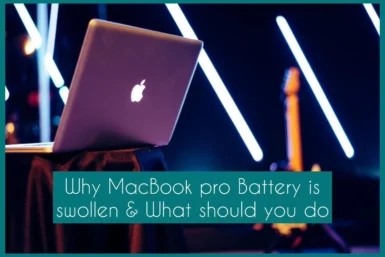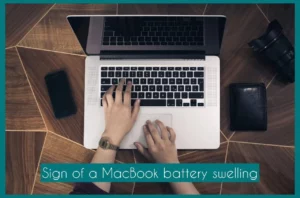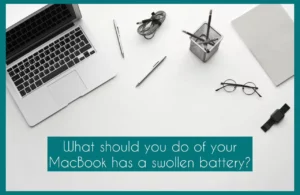Are you curious about the causes of a swollen MacBook Pro battery? If yes, then this article is for you.
In this article, we will talk about the causes. Highlight what you can do to address this problem successfully and guarantee your device’s best performance and security.
What Causes MacBook Pro Batteries to Swell?
The chemical processes inside MacBook Pro battery cells cause swelling. The internal battery parts degrade and break down over time because of repeated charge and discharge cycles, heat exposure, and environmental factors.
Gases are released due to this degradation, which accumulates and causes the battery to be swollen. The problem can worsen using non-original chargers, physical damage, or manufacturing flaws.
It’s important to act immediately since a swollen battery poses safety risks, including the possibility of rupture and damage to internal components.
Signs of A MacBook Battery Swelling
For immediate action, observing a swollen MacBook battery is essential. Look for warning indications, including a bent or bowed trackpad, bottom case, or keyboard. Your MacBook may not sit flat or wobble if the battery has swollen.
Rapid performance drops, decreased battery life, or unexpected shutdowns might indicate a swollen battery. Other red flags include a strange hissing noise, high heat, or an odd chemical smell coming from the Macbook.
For your safety and to prevent future harm to your MacBook, stop using the device immediately, unplug it from power sources, and get professional assistance.
Can You Still Use MacBook Pro with Swollen Battery?
It is recommended to avoid using a MacBook Pro with a swollen battery because it could be risky.
A swollen battery risks the laptop’s interior workings, strains the case, and may even burst or catch fire. It is dangerous for you and the MacBook to keep using an expanded battery.
Stop using the MacBook , unplug it from the power source, and get professional help to replace the battery.
What You Should Do if Your MacBook Has a Swollen Battery?
To ensure your safety and stop more harm, you must act quickly if you believe your MacBook’s battery is swollen. Here is a list of actions to take:
1. Stop Using the MacBook
Stop using the laptop as soon as you see any symptoms of a swelling battery, such as a warped frame, a shaky trackpad, or poor performance.
2. Unplug from Power
Disconnect the MacBook from all power sources, including chargers and accessories, to stop it from continuing to charge or from running the risk of an electrical shock.
3. Backup Your Data
If possible, back up all of your important information before obtaining professional assistance. By doing this, you may be confident that no important data is lost while the system is being repaired.
4. Contact Apple Support
Contact Apple Support or go to a licensed servicing facility. Qualified specialists can change The battery securely, and your MacBook’s functionality can be returned.
Things to Avoid if Your MacBook Has a Swollen Battery
Here is a list of things to avoid:
1. Avoid Ignoring It
Ignoring a swollen battery might result in more serious problems, such as permanent harm to your MacBook’s internal components or even safety risks like ruptures or fires.
2. Avoid DIY Repairs
Replacing a swollen battery demands knowledge and the right equipment. DIY repairs can result in more harm or personal injury.
3. Don’t Use
It’s dangerous to use a MacBook with a swollen battery. The issue can become worse with continued use, endangering your security.
In the end, a swollen battery is a significant issue that has to be handled immediately. Prioritise safety, get in touch with experts and take their advice to ensure a quick and secure fix for your MacBook.
How to Prevent MacBook Battery Swelling?
Effective measures to maintain longevity and safety are required to prevent MacBook battery swelling.
To avoid overcharging and overheating, use genuine Apple accessories and chargers. Extreme temperatures and intense sunshine should be avoided because they can damage the battery.
Update your MacBook’s firmware and operating system frequently to improve battery life. When not in use, use standard storage procedures, such as maintaining the battery at around 50% charge in a cold, dry environment.
To ensure correct charge readings, calibrate your battery regularly. Avoid any physical contact or improper handling that can harm the battery.
By following these recommendations, you may significantly reduce the possibility of battery swelling and guarantee your MacBook’s best performance.
Conclusion
In conclusion, identifying and treating a swollen MacBook battery is essential for safety and equipment durability. A safe and dependable MacBook experience can be attained by acting quickly, getting expert advice, and following preventive measures. To protect you and your device, put caution and maintenance first.



